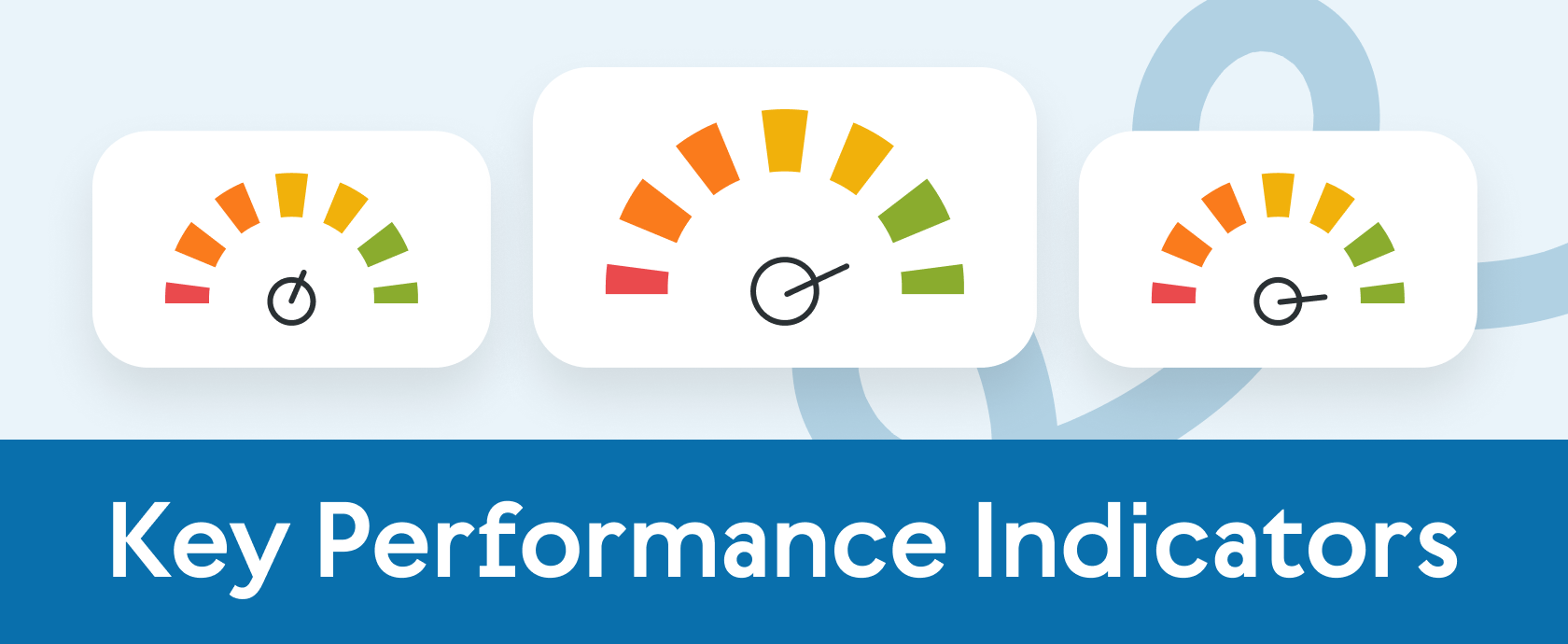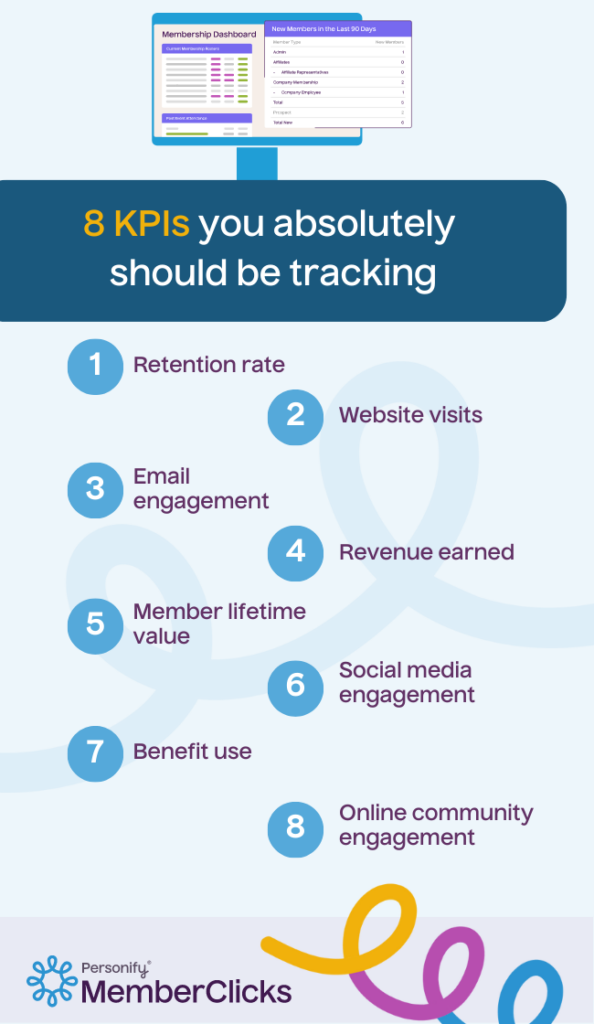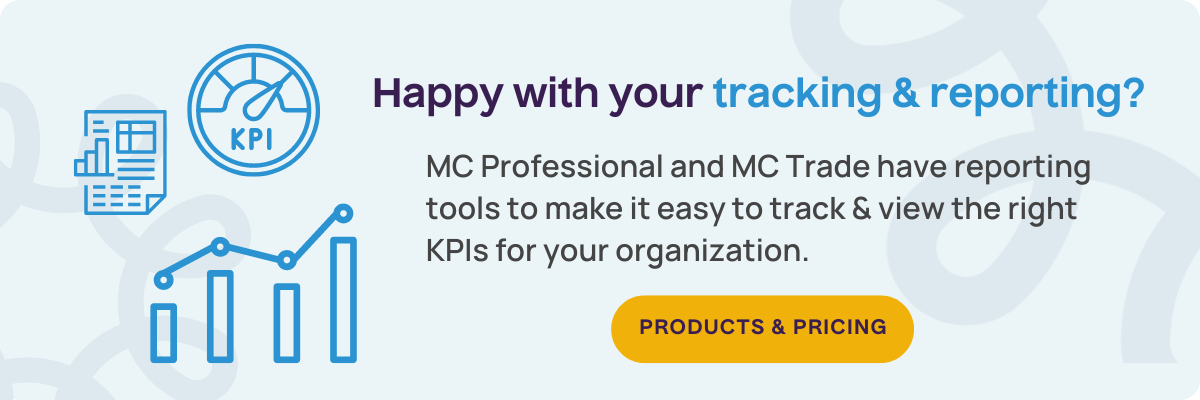How do you know how well your membership organization is performing? Easy! If your membership engagement metrics are high. But what are membership metrics? How do you set them? And how do you measure nonprofit organization performance via metrics?
That’s a lot of questions. Don’t worry. We’re here to help you get the answers.
Even if you’ve never heard of the acronym ‘KPI’ before, this article will teach you everything you need to know to decide which KPIs to adopt, how to measure them, and why you need to track and report on them monthly, quarterly and annually. Already know what a KPI is but need to refine your association metrics? This article is for you, too.
What are KPIs?

KPI stands for Key Performance Indicators. They are used in different industries and roles to measure success.
For you, YOUR KPIs should be core membership metrics that your organization tracks in order to understand how well you’re performing around everything from member retention to membership engagement.
When it comes to KPIs for membership organizations, they could include things like membership referrals, member satisfaction, email open rates, membership growth and more. Ultimately, KPIs are a way to track your performance over time so that you can spot trends, see how well changes are going over and correct your membership strategy when you misfire.
Why do KPIs matter?
KPIs matter for a wide variety of reasons. Here are some of the most important:
- Determine budget allocation: The KPIs that your organization chooses to measure can help you decide where to put your money. For example, if you’re prioritizing membership satisfaction, you might put more money into surveying your members and consulting with them to improve their satisfaction. Focused on membership growth? You could budget for membership referral bonuses.
- Report successes to board: KPIs help an organization (and the board) track their improvement and success over time. These are hard numbers that speak to the actual health of your membership association.
- Help to set achievable and realistic goals: Association metrics are important because understanding them and how they have historically trended helps your organization set more achievable goals. If your board decides they want you to double your membership next year but historically you’ve only ever grown your membership by 15% a year, metrics will help your association realize that doubling your membership isn’t likely to be achievable.
- Uncover trends in membership: Did your membership grow significantly after you implemented a new program? Did a lot of long-term members cancel after a leadership change? Trends showing improvements or losses in your membership metrics can help you double down on what’s working and correct for what isn’t.
- Help identify needs of members: Your membership won’t always tell you want they want. But they will speak with their actions. If they don’t renew or if attendance at your events goes down, that’s a good indicator that people aren’t happy with your membership association. You can use your KPIs to better understand the needs of your members.
- Prioritization of time an effort: If you know which membership metrics make the most impact on the health of your membership program, you can prioritize your staff’s time and effort towards meeting those metrics rather than trying to do everything with limited capacity.
Identifying the right success measurements for your membership organization
So, how do you best measure your nonprofit organization’s performance? Not every organization tracks the same association metrics. Why? Because each organization has different goals and are at different stages in their membership life cycle.
For example, a relatively new membership organization will be more focused on things like their membership acquisition rate compared to an older membership association that might be more focused on things like membership lifetime value and length of membership.
To zero in on the KPIs you should be tracking, ask yourself these two questions:
- What are your goals?
- What are your board’s goals?
Once you know the answer to these questions, you’ll know which KPIs are the most important. For example, if your goals are to keep your current members happy while acquiring members your KPIs should be focused on your membership retention and membership acquisition. Once there is an agreement on the KPIs your organization should be tracking – and who is responsible for them – you can focus your organization’s work to optimize for them.

Membership KPIs
Unsure what kind of membership metrics you could be measuring? Here are some popular association metrics.
✅ Member Net Promoter Score (NPS)
Why It Matters: NPS measures member satisfaction and loyalty by asking how likely members are to recommend your organization to others. It’s a valuable indicator of overall member sentiment and can predict retention and referrals.
How to Measure: Use surveys to ask members to rate their likelihood to recommend your organization on a scale from 0 to 10. Scores of 9-10 are promoters, 7-8 are passives, and 0-6 are detractors. Subtract the percentage of detractors from promoters to get your NPS.
✅ Member Churn Rate
Why It Matters: This measures the percentage of members who leave your organization over a set period. It’s crucial for understanding retention challenges and can help you identify patterns or reasons for membership drops.
How to Measure: Calculate by dividing the number of members lost in a period by the number of members at the beginning of that period.
✅ Average Membership Duration
Why It Matters: Average member tenure measures how long a member stays with your organization after joining. The longer the tenure, the healthier your organization is in terms of member retention. This metric is crucial because acquiring new members is often more costly than retaining existing ones. If your average member tenure is low, it could indicate issues with member engagement or satisfaction, signaling a need to improve your retention strategies.
How to Calculate:
- Add up the total length of membership for all members (in years, months, or days).
- Divide by your total number of members.
This KPI helps identify the effectiveness of your retention strategies and the overall satisfaction and engagement of your members.
✅ Average Time to Onboard New Members
Why It Matters: Understanding how long it takes to fully onboard new members can help identify bottlenecks in your onboarding process and improve member experience.
How to Measure: Track the time from when a new member joins to when they have completed all onboarding steps, such as attending orientation sessions, accessing key resources, and participating in initial events.
✅ Cost Per Member Acquisition
Why It Matters: This KPI helps you understand the efficiency of your marketing and recruitment efforts. It shows how much you spend to acquire each new member.
How to Measure: Total marketing and recruitment costs divided by the number of new members acquired during a specific period.
✅ Member Reactivation Rate
Why It Matters: This KPI tracks how many former members rejoin your organization. It’s useful for understanding the effectiveness of re-engagement campaigns.
How to Measure: Number of reactivated members divided by the total number of former members targeted in reactivation efforts.
✅ Member Referral Rate
Why It Matters: A high referral rate indicates strong member satisfaction and advocacy. It’s an important indicator of organic growth and word-of-mouth marketing.
How to Measure: Track the number of new members referred by existing members as a percentage of total new members.
✅ Membership Growth Rate (Quarter Over Quarter)
Why It Matters: Tracking membership growth quarter over quarter helps you understand how well your organization is attracting and retaining members. It’s a critical indicator of your organization’s financial health and long-term sustainability, as membership growth directly impacts revenue and budget planning. Regularly monitoring this metric allows you to identify trends, assess the effectiveness of your recruitment efforts, and adjust your strategies to optimize growth.
How to Measure: Calculate the percentage change in total membership from one quarter to the next. Subtract the previous quarter’s total membership from the current quarter’s total membership, divide by the previous quarter’s total, and multiply by 100.
✅ Member lifetime value:
Why It Matters: Member Lifetime Value quantifies the total revenue generated from a member during their entire membership. It includes both dues and non-dues revenue (such as event fees or merchandise purchases). Understanding MLV allows your organization to forecast future revenue and make informed decisions about member acquisition and retention strategies. If you can increase the average tenure of members, even small changes can significantly boost overall revenue.
How to Measure: Multiply the average annual revenue per member (dues plus non-dues) by the average membership tenure. This will give you the total expected revenue from an average member over their lifetime with your organization.
Measuring Member Engagement – KPIs to Track
It’s not enough to just track how much your membership has increased or declines. You should also be tracking how engaged your members are with your organization. Here are some KPIs that you can utilize to track member engagement.
✅ Create a Member Engagement Score
Why It Matters: An aggregate engagement score can be useful for assessing overall member involvement across different touchpoints, such as event attendance, content interaction, and participation in discussions.
How to Measure: Assign points for different activities (e.g., 5 points for attending an event, 3 points for posting in the community) and calculate a total engagement score for each member.
✅ Content Engagement Metrics
Why It Matters: Understanding which types of content (blogs, newsletters, social posts) engage your members most can inform your content strategy and ensure you’re delivering value.
How to Measure: Track metrics such as content views, average time spent on content, and interaction rates (comments, shares, likes).
✅ Email Engagement Rate
Why It Matters: This KPI tracks how engaged members are with your email communications, which can indicate their interest in your organization’s updates and offers.
How to Measure: Calculate the open rate and click-through rate (CTR) for your emails.
✅ Use of Membership Benefits
Why It Matters: Tracks how often members use available benefits, such as discounts, resources, or exclusive content. High usage rates indicate that members see value in their membership.
How to Measure: Track the number of members using each benefit divided by the total number of members.
✅ Online Community Activity
Why It Matters: Measures the level of participation in online forums, social media groups, or discussion boards. Active communities foster a sense of belonging and networking among members.
How to Measure: Track the number of posts, comments, or active users in your online community over a given time period.
✅ Advocacy Participation Rate
Why It Matters: For associations involved in advocacy or lobbying, measuring how many members participate in advocacy actions (e.g., signing petitions, contacting legislators) can show engagement and alignment with your mission.
How to Measure: Track the number of unique members participating in advocacy activities divided by the total number of members.
✅ Survey Response Rate
Why It Matters: A high survey response rate indicates that your members are actively participating and are willing to provide feedback. This engagement shows that members feel their opinions are valued and that they are invested in the organization’s success.
How to Measure: Divide the number of members who completed the survey by the total number of members who were asked to participate, and multiply by 100 to get the percentage
Event KPIs to Track
Now, you might be wondering how you measure success for individual events. Event-specific KPIs will look different than general organization metrics. But tracking success and measuring KPIs for events helps you to identify if your event was successful based on your goals and needs.
✅ Event Registration Rate
Why It Matters: Measures the effectiveness of your marketing and outreach efforts. A high registration rate indicates strong interest and effective promotion.
How to Measure: Compare the number of people who registered for the event to the number of people who were invited or targeted.
✅ Attendance Rate
Why It Matters: This KPI reflects the actual turnout at your event. A high attendance rate indicates that your event is compelling enough to motivate registered attendees to show up.
How to Measure: Divide the number of attendees by the number of registrants and multiply by 100 to get the percentage.
✅ Member vs. Non-Member Attendance
Why It Matters: Knowing the ratio of members to non-members can help assess whether your events are attracting potential new members or primarily serving existing ones.
How to Measure: Track the number of members and non-members attending the event and compare these numbers.
✅ Event Engagement Rate
Why It Matters: Measures how actively participants are engaging during the event. High engagement indicates that attendees are finding value and are actively participating in sessions, discussions, and activities.
How to Measure: Track metrics such as participation in Q&A sessions, live polls, social media interactions, or the number of questions asked during the event.
✅ Net Promoter Score (NPS) for Events
Why It Matters: NPS measures attendee satisfaction and their likelihood to recommend the event to others. A high score indicates a successful event experience.
How to Measure: Survey attendees after the event, asking them to rate how likely they are to recommend the event on a scale of 0 to 10. Subtract the percentage of detractors (0-6 scores) from promoters (9-10 scores).
✅ Session Attendance Rate
Why It Matters: Tracks which sessions are most popular among attendees. This can help you understand what topics are most relevant and engaging to your audience.
How to Measure: Compare the number of attendees in each session to the total number of event attendees.
✅ Revenue Generated
Why It Matters: Measures the financial success of the event, including ticket sales, sponsorships, and merchandise. Understanding revenue helps evaluate the return on investment (ROI) of your event.
How to Measure: Add up all revenue streams from the event, including registration fees, sponsorships, and additional sales.
✅ Cost per Attendee
Why It Matters: Helps determine the efficiency of your event budget. A lower cost per attendee indicates that you’re managing expenses well relative to the number of participants.
How to Measure: Divide the total cost of the event by the number of attendees.
✅ Sponsorship Engagement Rate
Why It Matters: Measures the effectiveness of sponsorship placements and interactions. High engagement indicates that sponsors are getting good value and visibility.
How to Measure: Track metrics such as sponsor booth visits, clicks on sponsor links, or participation in sponsored sessions or activities.
✅ Post-Event Survey Results
Why It Matters: Captures attendee feedback on various aspects of the event, such as content, organization, and overall satisfaction. High satisfaction scores suggest a successful event and can guide future planning.
How to Measure: Distribute a survey to attendees post-event and analyze the results to identify strengths and areas for improvement.
✅ Lead Conversion Rate
Why It Matters: Measures the effectiveness of the event in generating leads and converting them into members or customers. This KPI is particularly useful if your event is intended to drive membership growth or product sales.
How to Measure: Track the number of leads generated at the event and the percentage that convert into members or customers within a specific time frame.
✅ Repeat Attendance Rate
Why It Matters: Indicates attendee loyalty and satisfaction. A high repeat attendance rate means that attendees found value in previous events and are likely to continue participating in the future.
How to Measure: Compare the number of repeat attendees to the total number of attendees.
✅ Event Website Traffic
Why It Matters: Tracks the number of visitors to your event landing page. High traffic indicates effective promotion and interest in the event.
How to Measure: Use website analytics tools to monitor visits to your event page, including unique visitors and page views.
Tips on reporting your KPIs
Once you’ve decided which KPIs are important to your organization, it’s time to start reporting on them. But how do you do that most effectively? Here are some tips:
- Focus on what the numbers actually tell you: The numbers are important but they mean nothing alone. Your goal is to connect the numbers with what’s driving them. Figuring out the story behind the KPIs is critical. Did you make more money at your event this year because you had a silent auction? Or did you make more money because you sold more tickets? Animating your KPIs with this info is key for ensuring they’re meaningful to your organization.
- Look for trends over time: Looking at trends quarter over quarter or year over year helps your organization understand how changes or investments you’re making are paying off. That’s key to continue to improve your organization or to catch downward trends before its too late.
- Remember change can take time: While we all want to turn around the bad trends quickly or see significant growth, the big changes often don’t happen from one quarter to the next or even from one year to the next. Investing in optimizing and improving your association can take time. Make sure you manage expectations around your KPIs. You might want to even consult with similar organizations around what KPIs they have and what kind of growth they’re seeing.
- Adjust your goals as needed: KPI goals aren’t set it stone. The important thing is that you adapt on the ground as things change. If you had a goal of growing your membership revenue by 20% this year but your membership is facing financial stress, that’s unlikely to happen. Revise your goals to be better in line with your reality in those cases.
The right tools make tracking easy
You might be wondering how you’re going to track all these KPIs. If this is starting to sound like a massive make-work project, don’t worry. A great Association Management System (AMS) makes setting, tracking, and reporting on the KPIs we covered in this post easy.
Not only does a great AMS do it all automatically for you but it also allows you to view historical trends, store all your data securely and better understand membership engagement. Before you decide staying on top of your KPIs is impossible, consider finding an AMS that makes it simple if yours doesn’t.
Measuring success at your association
There’s a famous adage that you don’t do what you don’t measure and that’s especially true for associations. There are so many things to do and not enough people to do them. But the benefit of KPIs is that they can help your association zero in on the things that are most important to your organization. When you decide which KPIs are key to track and start analyzing your results, you can better understand and evaluate how the things you’re doing impact those metrics and focus on the things that generate the highest return on investment. That will cause your KPIs to improve much faster than doing what you’re currently doing.
Don’t have an AMS that makes tracking your KPIs over time simple? Consider MemberClicks. We help you focus on what matters most so you can focus on what makes the most impact.

















